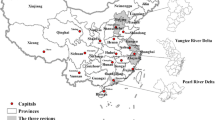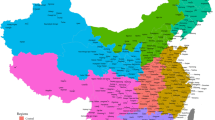Abstract
Shanghai is the largest commercial and industrial city of China, but air quality issues have hindered its development in becoming a “global city.” This study used monitoring data on SO2, NO x , acid rain pH, dustfall, and total suspended particles (TSP) from the Shanghai Environmental Monitoring Center to evaluate and analyze the air quality in urban, suburban, and rural areas during the period 1983–2005. The results showed that the spatial pattern of air parameters was determined by the level of urbanization; thus, the higher the level of urbanization, the worse the air quality. On the whole, the atmospheric environment of the three spatial regions improved gradually because of economical growth and environmental protection since the 1990s. For the entire region of Shanghai, the relationship between the integrated air quality index and gross domestic product (GDP) per capita was an N-shaped environmental Kuznets curve (EKC) due to decreasing air quality in suburban and rural areas this century. Thus, environmental controls should be increased in Shanghai, especially in developing suburban and rural areas during rapid urbanization.




Similar content being viewed by others
References
Berry RD, Colls JJ (1990) Atmospheric carbon dioxide and sulphur dioxide on an urban/rural transect-II. Measurements along the transect. Atmos Environ 24(10):2689–2694
Bruyn SM, Opschoor JB (1997) Developments in the throughput-income relationship: theoretical and empirical observations. Ecol Econ 20(3):255–268
Collett RS, Oduyemi K, Davidson B (1997) An investigation into ambient levels of traffic-related pollutants in urban centres: a case study of the seagate, Dundee, United Kingdom. J Environ Manage 51:289–304
de Bruyn SM, van den Bergh JCJM, Opschoor JB (1998) Economic growth and emissions: reconsidering the empirical basis of environmental Kuznets curves. Ecol Econ 25(2):161–175
Energy Information Administration (2000) International energy outlook 2000. US Department of Energy, Washington
Feddema JJ, Meieriding TC (1987) Marble weathering and air pollution in Philadelphia. Atmos Environ 21(1):143–157
Fenger J (1999) Urban air quality. Atmos Environ 33:4877–4900
Forms M, Boyce JK (1998) Income, inequality, and pollution: a reassessment of the environmental Kuznets curve. Ecol Econ 25(2):147–160
Fried B, Getzner M (2003) Determinants of CO2 emissions in a small open economy. Ecol Econ 45(1):133–148
Garg AN, Chutke NL, Ambulkar MN, Aggarwal AL (1995) An environmental pollution study of Indian metropolitan cities and industrial surroundings by INAA. J Radioanal Nucl Chem 192(2):307–320
Gargava P, Aggarwal AL (1996) Industrial emission in a coastal region of India: prediction of impact on air environment. Environ Int 22(3):361–367
Grossman GM, Krueger AB (1991) Environmental impacts of a North American free trade agreement. NBER Working Paper 3914, National Bureau of Economic Research (NBER), Cambridge
Grossman GM, Krueger AB (1995) Economic growth and the environment. Q J Econ 110(2):353–379
Harrison RM, Jones AM, Lawrence RG (2004) Major component composition of PM10 and PM2.5 from roadside and urban background sites. Atmos Environ 38:4531–4538
He LY, Hu M, Huang XF, Zhang YH, Tang XY (2006) Seasonal pollution characteristics of organic compounds in atmospheric fine particles in Beijing. Sci Total Environ 359:167–176
Huang Z, Zhang X, Wan G (2001) Development stratagem of alternative fuel of automobile (in Chinese with English Abstract). China Energy 8:30–33
Huang Z, Zhang X (2006) Well-to-wheels analysis of hydrogen based fuel-cell vehicle pathways in Shanghai (in Chinese with English Abstract). Energy 31:471–489
Hueglin C, Gehrig R, Baltensperger U, Gysel M, Monn C, Vonmont H (2005) Chemical characterisation of PM2.5, PM10 and coarse particles at urban, near-city and rural sites in Switzerland. Atmos Environ 39:637–651
Jerrett M, Arain A, Kanaroglou P, Beckerman B, Potoglou D, Sahsuvaroglu T, Morrison J, Giovis C (2005) A review and evaluation of intraurban air pollution exposure models. J Expo Anal Environ Epidemiol 15:185–204
Kan HD, Chen BH (2004) Particulate air pollution in urban areas of Shanghai, China: health-based economic assessment. Sci Total Environ 322:71–79
Ke BH, Hong H, Qiang Z (2002) Urban air pollution in china: current status, characteristics, and progress. Annu Rev Energy Environ 27:397–431
Krupa SV, Legge AH (1995) Air quality and its possible impacts on the terrestrial ecosystems of the North American great plans: an overview. Environ Pollut 88:1–11
Li J, Guttikunda SK, Camichael GR, Streets DG, Chang Y-S, Fung V (2004) Quantifying the human health benefits of curbing air pollution in Shanghai. J Environ Manage 70:49–62
Li X, Zhu J, Guo P, Wang J, Qiu Z, Lu R, Qiu H, Li M, Jiang D, Li Y, Zhang G (2003) Preliminary studies on the source of PM10 aerosol particles in the atmosphere of Shanghai City by analyzing single aerosol particles. Nucl Instrum Methods Phys Res B 210:412–417
Liu XZ, Heilig GK, Chen JM, Heino M (2007) Interactions between economic growth and environmental quality in Shenzhen, China’s first special economic zone. Ecol Econ 62:559–570
Luhar AK, Venkatram A, Lee S-M (2006) On relationships between urban and rural near-surface meteorology for diffusion applications. Atmos Environ 40:6541–6553
Ma CJ, Oki Y, Tohno S, Kasahara M (2004) Assessment of wintertime atmospheric pollutants in an urban area of Kansai, Japan. Atmos Environ 38:2939–2949
Monn C, A-Kirkpatrick P, Künzli N, Defila C, Peeters A, A-Liebrich U (1999) Air pollution, climate and pollen comparisons in urban, rural and alpine regions in Switzerland. Atmos Environ 33(15):2411–2416
Mu HL (2008) Analysis on characteristics of environmental Kuznets curve of Beijing (in Chinese with English Abstract). Ecol Econ 5:366–368, 380
Panayotou T (1997) Demystifying the environmental Kuznets curve: turning a black box into a policy tool. Environ Dev Econ 2:465–484
Putaud JP, Raes F, Van Dingenen R, Brüggemann E, Facchini MC, Decesari S, Fuzzi S, Gehrig R, Hüglin Cm Laj P, Lorbeer G, Maenhaut W, Mihalopoulos N, Müller K, Quero X, Rodriguez S, Schneide J, Spindler G, ten Brink H, Tørseth K, Wiedensohler A (2004) A European aerosol phenomenology-2: chemical characteristics of particulate matter at kerbside, urban, rural and background sites in Europe. Atmos Environ 38:2579–2595
Robert K, Kaufmann RK, Davidsdotfir B, Gamham S, Pauly P (1998) The determinants of atmospheric SO2 concentrations: reconsidering the environmental Kuznets curve. Ecol Econ 25(2):209–220
Sengupta S, Patil RS, Venkatachalam P (1996) Assessment of population exposure and risk zones due to air pollution using the geographical information system. Comput Environ Urban Syst 20(3):191–199
Shanghai Census Bureau (2005) Shanghai Population in 21st Century (in Chinese). Chinese Statistical, Shanghai, pp 257–258
Shanghai Environmental Protection Bureau (1984–2006) Report on Environmental Quality of Shanghai 1983–2005 (in Chinese). Shanghai Environmental Monitoring Center, Shanghai
Shanghai Statistical Bureau (1984–2006) Shanghai Statistical Year Book 1983–2005 (in Chinese). Chinese Statistical Press, Shanghai
Shao M, Tang XY, Zhang YH, Li WJ (2006) City clusters in China: air and surface water pollution. Front Ecol Environ 4(7):353–361
Shen MH, Xu YH (2000) A new environmental Kuznets’ curve-study on the relationship between the economic growth and the change of the environment in the process of Zhejiang Province’s industrialization (in Chinese with English Abstract). Zhejiang Soc Sci 4:53–57
Shu J, Dearing JA, Morse AP, Yu LZ, Yuan N (2001) Determining the sources of atmospheric particles in Shanghai, China, from magnetic and geochemical properties. Atmos Environ 35:2615–2625
Singh M, Goel P, Singh AK (2005) Biomonitoring of lead in atmospheric environment of an urban center of the Ganga Plain, India. Environ Monit Assess 107:101–114
So KL, Wang T (2003) On the local and regional influence on ground-level ozone concentrations in Hong Kong. Environ Pollut 123:307–317
State Environmental Protection Administration (1996) Ambient Air Quality Standard of China
Sun JW (1999) The nature of CO2 emission Kuznets curve. Energy Policy 27(12):691–694
Sun YL, Zhuang GS, Wang Y, Han LH, Guo JH, Dan M, Zhang WJ, Wang ZF, Hao ZP (2004) The air-borne particulate pollution in Beijing-concentration, composition, distribution and sources. Atmos Environ 38:5991–6004
Tao XG, Hong CJ, Yu SZ, Chen BH, Zhu HG, Yang MD (1992) Priority among air pollution factors for preventing chronic obstructive pulmonary disease in Shanghai. Sci Total Environ 127:57–67
Taskin F, Zaim O (2001) The role of international trade on environmental efficiency: a DEA approach. Ecol Model 1(1):1–17
Vardoulakis S, Gonzalez-Flesca N, Fisher BEA, Pericleous K (2005) Spatial variability of air pollution in the vicinity of a permanent monitoring station in central Paris. Atmos Environ 39:2725–2736
Wang JY, Da LJ, Song K, Li BL (2008) Temporal variation of surface water quality in urban, suburban and rural areas during rapid urbanization in Shanghai, China. Environ Pollut 152:387–393
Weisbrod RE (1999) Solving China’s urban crisis: China’s transportation energy future. J Urban Technol 6(1):89–100
Wilson JG, Kingham S, Sturman AP (2006) Intraurban variations of PM10 air pollution in Christchurch, New Zealand: implications for epidemiological studies. Sci Total Environ 367:559–572
World Bank (1997) Clear water, blue skies: China’s environment in the new century. World Bank, Washington
World Bank (2006) China’s development priorities. Shahid Yusuf and Kaoru Nabeshima, Washington
Wu WP (1999) City profile: Shanghai. Cities 16(3):207–216
Xu DD, Dan M, Song Y, Chai ZF, Zhuang GS (2005) Concentration characteristics of extractable organohalogens in PM2.5 and PM10 in Beijing, China. Atmos Environ 39:4119–4128
Yao ZQ (1979) Several suggestions about the application of environment quality index. Environ Sci 2:37–45 (in Chinese)
Zhao SQ, Da LJ, Tang ZY, Fang HJ, Song K, Fang JY (2006) Ecological consequences of rapid urban expansion: Shanghai, China. Front Ecol Environ 4(7):341–346
Zhao XK, Li JM, Wang JY, Zhou CQ (2005) Prove of EKC in China (in Chinese with English Abstract). Nankai Econ Study 3:48–54
Ziska LH, Bunce JA, Goins EW (2004) Characterization of urban-rural CO2/temperature gradient and associated changes in initial plant productivity during secondary succession. Oecologia 139:454–458
Acknowledgments
We would like to thank the anonymous reviewers and managing editor for constructive comments and suggestions. This research was supported by the National Natural Science Foundation of China (40971041), the Science and Technology Ministry of China “11th five-year” Key Science and Technology Supported Project (2008BAJ10B04), and Tokyo University of Information Sciences, which is funded by Ministry of Education, Culture, Sports, Science, and Technology (MEXT) support program S0801024.
Author information
Authors and Affiliations
Corresponding author
Rights and permissions
About this article
Cite this article
Xia, TY., Wang, Jy., Song, K. et al. Variations in air quality during rapid urbanization in Shanghai, China. Landscape Ecol Eng 10, 181–190 (2014). https://doi.org/10.1007/s11355-011-0174-z
Received:
Revised:
Accepted:
Published:
Issue Date:
DOI: https://doi.org/10.1007/s11355-011-0174-z




